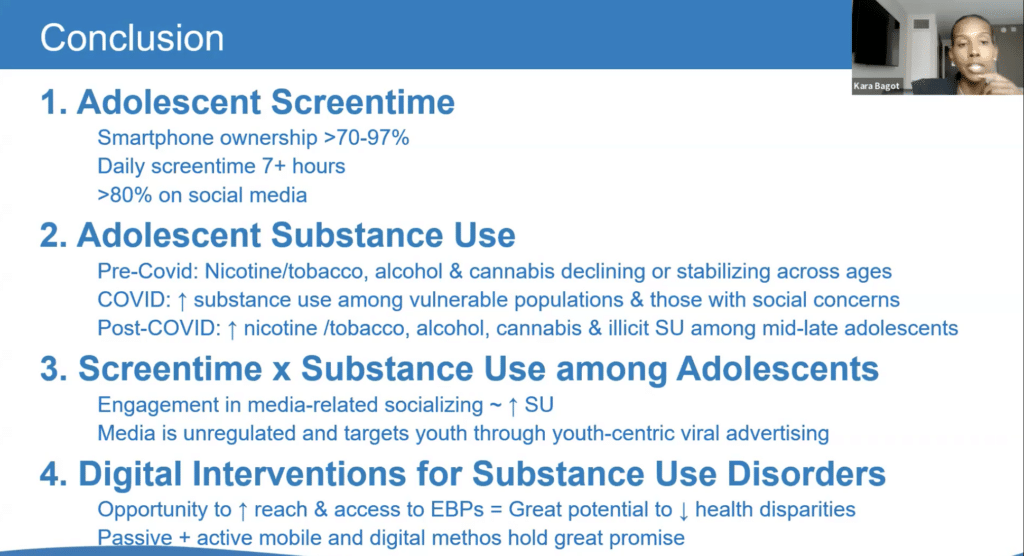Dr. Kara Bagot closed out our 2023 Zarrow Mental Health Symposium keynote sessions with a fascinating, if not jarring, presentation on trends in adolescent addiction. Keeping with the modern world in which we live, she spoke not just of substance use, but also of technology addiction, as well as the impact of covid on trends in these two areas.
Dr. Bagot explored four main components, including: adolescent screen time, adolescent substance use, the interaction between screen time and substance use, and digital interventions for substance use disorders.
It’s no surprise that with each age group, you see an increase in smartphone ownership, but most alarming is how young it begins. Her data began at age eight, and from 2015 to 2021, the rate of eight-year-olds who owned a smartphone tripled, going from 11% to 33% in that short time. And when you look at 17 and 18 year-olds, you’ll see nearly 100% smartphone ownership.
Data showed that these kids (grouped into teens, ages 8-12 and tweens, ages 13-18) are using their smartphones primarily for online videos and television, followed closely by social media for teens. The pandemic only exacerbated these numbers.
There’s an interesting, yet not terribly surprising, contrast between the two groups: The enjoyment rate of tweens who used social media increased by 4%, and the frequency rose by 5-7%. For teens, however, the frequency stayed about the same, but the enjoyment decreased by 7%.
When Dr. Bagot moved to the second component regarding adolescent substance use; she opted to share the percentages on her slides, but primarily focus on the trends – and with good reason.
It began with the good news that pre-COVID, we saw drops in youth – particularly older teenagers – nicotine vaping usage. This was largely due to the December 2019 Federal Food Drug and Cosmetic Act Amendment that raised the purchasing age from 18 to 21, and the halting of JUUL’s viral social media vape advertising campaigns to teenagers.
It’s worth mentioning that, in contrast, amphetamine, inhalant, and cough medicine misuse trended upward, which is an unsurprising find, given the relatively easy access.
Throughout the pandemic-induced lockdown period, there was a decrease in binge drinking and vaping, but an increase in frequency of alcohol and cannabis use. The greatest predictors for this behavior? Popularity, reputation, and Covid-related fears.
Coming out of the pandemic, we’re seeing an uptick in tobacco use and substance use in teens.
In looking at the covid aftermath, it’s clear that those with COVID-related vulnerabilities were more likely to use substances, as were those with known substance use vulnerabilities such as parental substance use, peer substance use, or psychopathology.
Additionally, the opioid use epidemic has accelerated coming out of the pandemic, tripling among teenagers and rising five times among black teens. With fentanyl’s potency at 100 times that of morphine, this was an alarming stat to learn.
Overdose disproportionately affects underrepresented minorities. rNative and black populations are particularly underserved in mental health and addiction services due to less economic, clinical, or social resilience that facilitates pushback against these drugs coming into those communities.
The interaction between screen time and substance use among adolescents is clear. Youth are most likely to glamorize substance use through Instagram posts, and they are most likely to post photos associated with negative consequences of substance use to snapchat (with the somewhat erroneous theory that it disappears).
Dr. Bagot showed a graph that drew clear parallels between texting and substance use behaviors. As texting trended upward, so did substance use. Talking on the cell phone was similar, as was video chatting and social networking. Rates were particularly high where there was obvious continuous and immediate feedback.
Paid industry advertising and the media are key influencers in substance use. Youth have underdeveloped cognitive capacities to distinguish ads from real life and that poor executive control makes them susceptible to stylistic features such as animation, frequent camera cuts and loud or fast music.
Preoccupation with personal image and identity is also a notable factor.
Digital interventions for substance use disorders begin with multi-system level data capture. Smart phones can give us environmental, physiological, behavioral and psychological risk factor information that we know is important. This then allows for deeper understanding of how individuals interact with each other, as well as in different contexts. Since they allow for precise and objective measurement, we can begin to develop targeted risk-behavior responsive treatment (which require anonymity), as well as incorporate evidence-based practices.
Mobile digital/technologically-based interventions are optimal for youth, given their environmental constraints such as school schedules, financial dependence and concerns around confidentiality. And also, youth are digital natives, more adept at using digital tools.
Other critical and effective prevention approaches include legislation that restrict advertising and sales of products appealing to youth, media literacy, and platforms that offer active treatment interventions such as MobilCoach and E-CHUG.
Dr. Bagot’s opinion, based on her research, is that the future of digital intervention for youth is really passive smartphone data. One of the most obvious aspects is that most people have their smartphones with them at all times. GPS data provides valuable insight, as does the tracking of how people interact with their smart phones – particularly in regards to social engagement.
She rounded out her presentation with Wearables – another innovative tool that uses the interplay between electricity and chemistry. Distinct electrochemical fingerprints of a target drug in real time without measurement of specific metabolites of predetermined thresholds of use in a low-burden way. Individuals don’t have to go anywhere for drug testing, making it easier to engage in substance use treatment while living their real lives.

